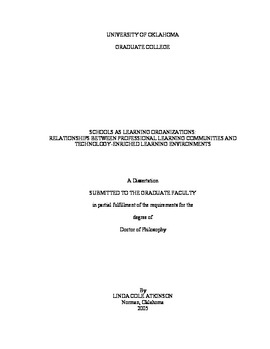| dc.contributor.advisor | O'Hair, Mary John, | en_US |
| dc.contributor.author | Atkinson, Linda Cole. | en_US |
| dc.date.accessioned | 2013-08-16T12:19:48Z | |
| dc.date.available | 2013-08-16T12:19:48Z | |
| dc.date.issued | 2005 | en_US |
| dc.identifier.uri | https://hdl.handle.net/11244/864 | |
| dc.description.abstract | During the last decade there has been a significant increase in the availability of technology in schools; unfortunately, research indicates the integration of technology in the teaching and learning process has been minimal (Becker, 2001). Cuban (2001) reports professional development is as crucial for technology integration as access to the equipment. Effecting change in schools as learning organizations involves developing collaborative relationships and a shared vision of the desired results. Research has identified that professional learning communities provide teachers collaborative and supportive environments for on-going learning (Hord, 1997; Kruse, Louis, & Byrk, 1995). Professionally engaged teachers are more likely to integrate constructivist computer applications (Becker & Riel, 2000) and are more likely to be supported in the learning environment of a professional learning community. | en_US |
| dc.description.abstract | The findings of this study demonstrated a medium correlation between the characteristics of professional learning communities and the factors of technology integration. All five dimensions of professional learning communities exhibited significant positive relationships with six of the nine factors of technology integration. The dimension of peer review and feedback indicated significant positive relationships with four factors that influenced incorporating technology, including teachers' instructional use of technology, sharing best technology practices, students' use of technology, and positive beliefs towards technology use. Results illustrated the effect of combining professional learning communities and integrating technology to increase teachers' peer interactions. Relationships with the greatest correlation coefficients were between the technology integration factor of support teachers received for using technology and the five dimensions of professional learning communities, demonstrating effects of staff's interconnections on supportive conditions for technology integration. This study's findings provided valuable information for preparation programs and school leaders as they address the integration of technology in the teaching and learning process to impact student achievement. | en_US |
| dc.description.abstract | This quantitative study's purpose was to investigate the empirical relationship between professional learning communities and the integration of technology in the teaching and learning process. Data sources included two pre- and post-survey instruments for 218 teachers, cross-sectional survey instruments for 23 administrators, and grant documentation. These data were analyzed using correlational analysis to describe the nature of the relationships. | en_US |
| dc.format.extent | xv, 212 leaves : | en_US |
| dc.subject | Educational technology. | en_US |
| dc.subject | Education, Technology of. | en_US |
| dc.subject | Educational technology Oklahoma. | en_US |
| dc.subject | Education, Curriculum and Instruction. | en_US |
| dc.title | Schools as learning organizations: Relationships between professional learning communities and technology-enriched learning environments. | en_US |
| dc.type | Thesis | en_US |
| dc.thesis.degree | Ph.D. | en_US |
| dc.thesis.degreeDiscipline | Department of Educational Leadership and Policy Studies | en_US |
| dc.note | Source: Dissertation Abstracts International, Volume: 66-02, Section: A, page: 0466. | en_US |
| dc.note | Adviser: Mary John O'Hair. | en_US |
| ou.identifier | (UMI)AAI3163444 | en_US |
| ou.group | Jeannine Rainbolt College of Education::Department of Educational Leadership and Policy Studies | |
